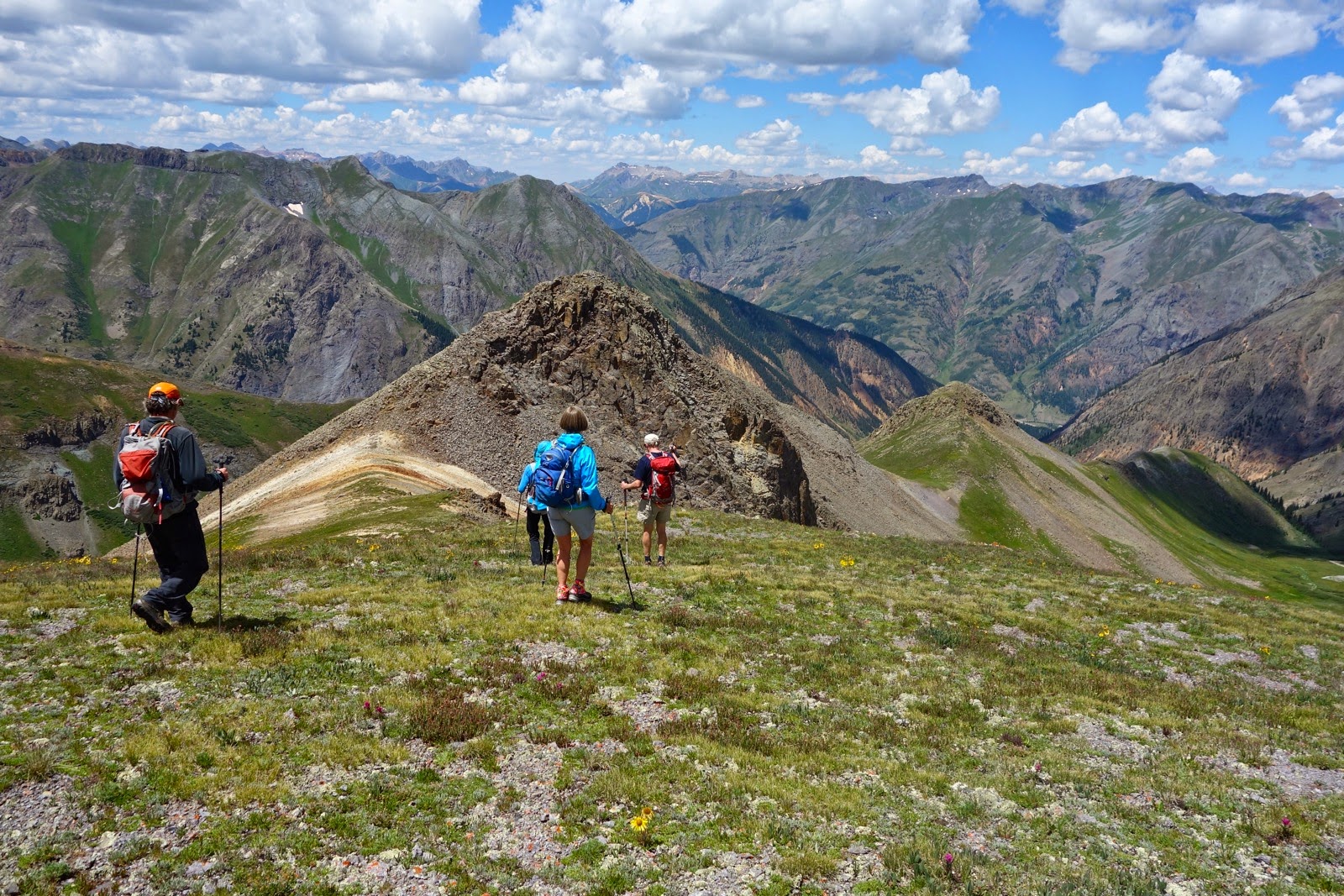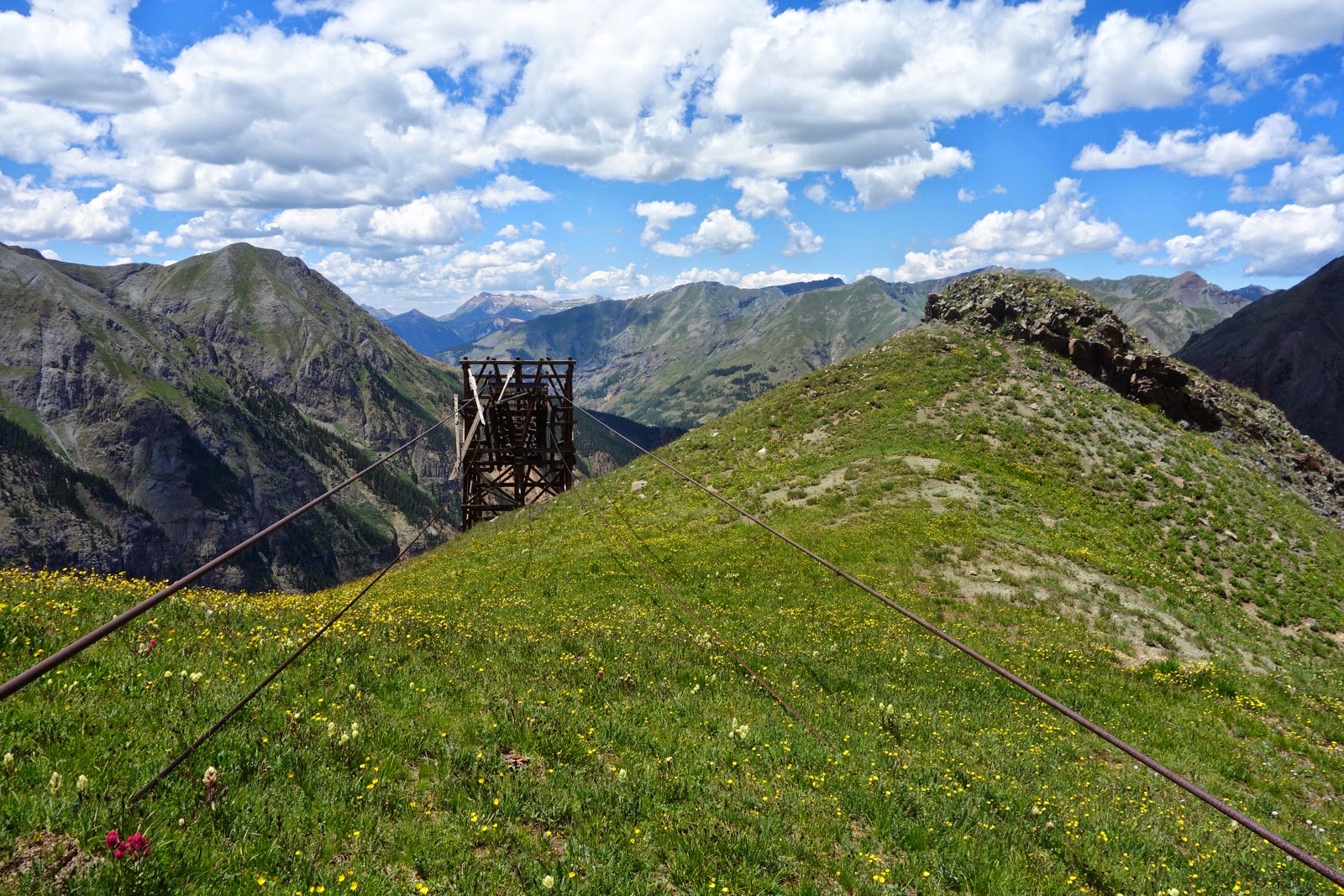Travel: From the US 550/160 intersection in Durango, drive north on US 550 towards Silverton. At 35 miles, top Coal Bank Pass and continue down the other side. As the road begins climbing Molas Pass, it makes a horseshoe bend to the right. Park just before the apex of this curve at a large turn-out on the right/east side of the road at mile marker 60.2. The hike begins 0.1 mile up the road, across the highway. Allow 45 minutes from Durango.
Distance and Elevation Gain: 11.5 miles, 4,400 feet of climbing
Time: 8:00 to 9:00
Difficulty: Trail, primarily off-trail; navigation considerable; mild exposure
Maps: Engineer Mountain; Ophir, Colorado 7.5 Quads
Dates Hiked: September 1, 2007, August 7, 2011, August 30, 2014
Quote: Grown together; friends forever. (source unknown)
Point 13,205' and Twin Sisters from Jura Knob, two miles to the south.
Route: While it is possible to climb Twin Sisters from the South Fork of Mineral Creek or the Colorado Trail Trailhead at Little Molas Lake, this counterclockwise stem-and-loop originates at the Lime Creek TH, 9,800'.
From the TH, take the main trail that goes down towards the creek, ignoring the faint path on the right. The undulating track points north, staying east of the creek, sometimes quite close, but mostly well above the water. Grassy clearings are interspersed with old growth conifer. In 0.5 mile, cross North Lime Creek with its cascade series. In June, 2005, this tributary was a trip ender, running too deep and swift to cross.
Make good time on this straightforward pathway. In 1.6 miles, the trail splits at the second tributary. Stay left, crossing the stream on the main trail. At 1.8 miles, reach a clearing marked by a large boulder, shown. Leave the trail here at 10,300'. (THW, photo)
The next objective is to intersect the Colorado Trail (CT). The most favorable route stays just left of the rounded ridge. While there are two steep sections with rock outcrops, the slope is most forgiving on this aspect. Trees are politely spaced. At 2.4 miles, 11,400 feet, reach the CT. (THW, photo)
Walk east/right on the CT for 0.6 mile to Lime Creek. Mid-summer, the osha is literally shoulder high. Plan to rest on top of the Telluride Conglomerate boulder seen below and contemplate this fellow that peeled off the cliffs above. The Cutler Formation records the unroofing of the Rockies. It is named for outcrops near the mouth of Cutler Creek, north of Ouray. Laid during the Permian age, 252 to 298 million years ago, the red color comes from iron-oxide compounds deposited with the sand and mud. This loop route is rendered possible by two faults in the Telluride Conglomerate and Cutler Formation. The next objective is to pierce the break at the apex of the Lime Creek drainage.
Leave your perch, cross Lime Creek, staying eastward on the CT another 0.2 mile or so. Where the CT curves SE, search around for a faint secondary trail and turn left/north. If you can't locate it, no worries. Just stay well east of the creek, heading straight for the cleft. As you approach the rift, the trail becomes more distinct. (THW, photo)
Here's a snap looking back into the Lime Creek valley. The Twilights are just right of center. (THW, photo)
At 3.7 miles, 12,100 feet, top the Telluride Conglomerate and see East Sister for the first time, center left below. The peaceful walk to Saddle 12,300', north of Peak 12,601', is sure to infuse you with tundra euphoria. Once, I went SW and topped the knoll at 12,200' before swinging around NW to reach this saddle. However, there is a well cairn'd route that goes to the saddle, shown on the track above. Watch for golden eagles and snowshoe rabbits. Reach the saddle at 4.6 miles. (THW, photo)
Right at the saddle there is a small cliff with an amber colored vein. Quartz crystals coat some of the surfaces. Likely, hot water with dissolved silica and iron caused the deposit along a fracture in the rock. (THW, photo)
At Saddle 12,300', make a climbing strategy for East Sister. Turn SW and descend to a soft swale at 12,200'. In wet years, there will be a pond in the depression. Climb the broad east ridge, using the grass as long as you can. There are bits of social trail. The grade steepens, becoming most angular 150 feet below the NE ridge. Here some will feel a disconcerting sense of potential tumbling exposure. Enter more solid rock just below the ridge and the footing improves. (THW, photo)
Gain the ridge and enjoy the gentle, sweet climb to the summit at 5.8 miles. This image looks back on the NE ridge from the crest. (THW, photo)
Vermilion Peak, 13,894', center, dominates the Ice Lake cluster. (THW, photo)
It is 0.6 mile between the twins. As you descend SW from East Sister, come to a 15 foot cliff. Pay attention as you traverse it on the east side. Return to the ridge at first opportunity. Arrive at Saddle 13,000' in 6.1 miles. It will feel quite welcome to have no complications climbing 374 feet to West Sister. (THW, photo)
From the crest (at 6.4 miles), to the south is Pt 13,205', with masculine Engineer Mountain hovering close by. Of course East Sister, best friend forever, is inseparable. (THW, photo)
Psych yourself up for the trip home which has its share of demands. Return to Saddle 13,000'. Drop east, picking your way down a rock glacier. At the abrupt edge of the glacier's toe, jog way left, or stay in the lowest ravine on the right, shown below. (THW, photo)
Descend 800 feet from the saddle to the top of the dramatic Cutler Formation. If there is a crux in this climb, this is it. There are two ways to penetrate this wall: climb down the gully (center in the image below), or slide down a scree slope (far left). Most people will choose the scree, scooting down next to the wall. There is a distinct path leading to the plunge, seen below. If you are doing an out-and-back along this route, it works nicely to climb up the gully and slide down the scree. The gully is steep and wet. You will be in the streambed so avoid it during high runoff. (THW, photo)
Here's a look at the options from below. The gully is in the center and the scree slide, on the right.
The final 400 feet of descent to the CT is tedious but beauty compensates. Blue bells and corn husk lilies are thigh high, there are rivulets to hop across, and gargantuan Cutler boulders randomly strewn about to dodge. Reach the CT at mile 7.7. These boulders reside beside the trail. (THW, photo)
The next challenge is to get yourself back to the Lime Creek trail. Once, I simply crossed the CT, held my SE bearing, and dropped 900 very rugged feet to the trail. Brush and deadfall were interspersed with swamps. As seen on the map above, another time I walked east on the CT 0.6 mile to an opening in the forest on the point of a ridge. This was a better choice. Go due south. It is easy at first; then the ridge steepens for 600 feet but there is little woody entanglement. Reach the trail at 8.9 miles, 10,600'. It is a fast walk back to the TH at mile 11.5. There is plenty to admire along the way such as this salsify seedhead. Just before reaching the highway, notice multiple beaver dams in the creek below.
(THW, photo)
Alternate Route: Once I climbed Twin Sisters by starting at Little Molas Lake (elevation 10,900 feet) and heading west on the Colorado Trail. The mileage is longer but the elevation gain is less, and the navigation is considerably simpler. Take the CT for 5.0 miles until you are about 0.2 mile east of Lime Creek. A faint path peels off the CT and heads up through the cleft. Continue as described up East Sister and over to West. Return as you came, or follow the above route from Saddle 13,000' back to the CT. Return to your vehicle at Little Molas Lake or at the Lime Creek TH if you spotted one there.




















































